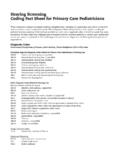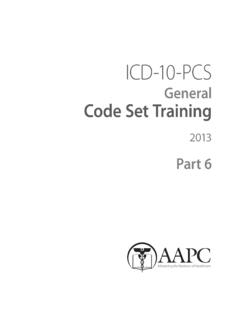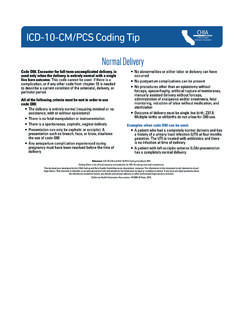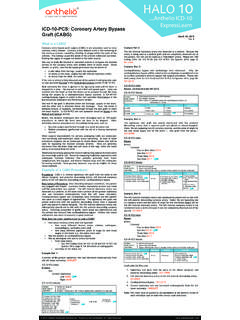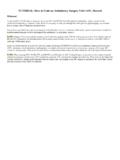Transcription of Complex Coding Decisions Using ICD-10-PCS, Part 4
1 Complex Coding Decisions Using ICD-10-PCS, Part 4 Lynn Kuehn, MS, RHIA, CCS-P, FAHIMAK uehn Consulting, LLCW aukesha, WI 53186(262) Objectives At the conclusion of this program, you will be able to: Describe the system design for ICD-10-PCS Compare and contrast the root operation groups Differentiate between similar root operations Using critical thinking skills Identify the root operations assigned for 10 common PCS cases Determine the remaining characters in each code for 10 common PCS cases2 PCS FilesDownload the PCS files from: 2015 Code Tables and Index 2015 Official ICD-10-PCS Coding Guidelines 2015 ICD-10-PCS Reference Manual Use electronic version too big to print3 Code Structure2345671 SectionBody SystemRoot OperationBody PartApproachDeviceQualifier4 ICD-10-PCS Index Provides the first three or four characters of the code Refers the coder to the correct code table The code tables must always be used to obtain the complete code5 ICD-10-PCS TablesEach table contains four columns and a varying numbers of rowsColumn:Specifies the allowable values for characters 4 through 7 Row.
2 Specifies the valid combinations of values6 Root OperationsAlteration Bypass ChangeControlCreationDestructionDetachme ntDilationDivisionDrainageReleaseRemoval RepairReplacementRepositionResectionRest rictionRevisionSupplementTransferTranspl antationExcisionExtirpationExtractionFra gmentationFusionInsertionInspectionMapOc clusionReattachment7 Nine Root Operation GroupsRoot operations that take out some or all of a body partRoot operations that take out solids, fluids, or gases from a body partRoot operations that involve cutting or separation onlyRoot operation that put in, put back, or move some or all of a body part8 Nine Root Operation GroupsRoot operations that always involve a deviceRoot operations that involve examination onlyRoot operations that define other repairsRoot operations that define other objectivesRoot operations that alter the diameter or route of a tubular body part9 What is the intent of the procedure?
3 10 Take Out Group11 To determine whether it s Excision or Resection, always start in the Index under the heading Resection. All body parts can be vs of left lobe of thyroid of apex of pylorus of of left of left lobe of thyroid gland of apex of tongue pylorus of stomach of left testis ResectionTable 0BT15 AnswersResectionExcisionResection x 2 Case #1He presents with a right upper lobe pulmonary nodule. The patient was taken to the OR and an incision was made over the sixth rib. The lung was explored and only the single lung nodule was wedge resection was performed Using a tissue stapler, removing the lesion and a 2 cm margin. The specimen was sent for frozen section. The findings returned as metastatic colon cancer, with clear margins in the specimen. The ribs were approximated and the chest wall was closed in layers.
4 The subcutaneous tissue and skin were to be made?18 Case #1 Poll QuestionWhich root operation is it? #1 Which root operation?ExcisionWhich body part value will we pick?Right upper lobe of the lung20 Case #10 BBC0ZX21 Gunk Group22 Excision and Extraction removes body parts Extirpation removes foreign objects from a body part23 Case #2 PREOPERATIVE DIAGNOSIS: Abnormal EKG suggestive of anterior DIAGNOSIS: artery disease 2. Thrombus in proximal diagonal branch with severe stenosisPROCEDURES: heart catheterization with pressure ventricular angiography, right and left coronary angiography Using branch mechanical thrombectomy, angioplasty and stenting with a x 12 mm long Promus Element DES stent deployment for hemostasis24 Case #2 Root operations to assign? Extirpation Dilation Measurement Fluoroscopy25 Case #22602C03ZZ, 027034 ZCase #24A023N7, B2151ZZ, B2111ZZ27 Case #202C03 ZZThrombectomy (Extirpation)027034 ZPTCA (Dilation) with Drug-eluting stent4A023N7 Left heart catheterizationB2151 ZZLeft ventriculogram with low osmolar contrastB2111 ZZCoronary angiogram (multiple) with low osmolar contrast28 Cutting Group29 Fasciotomyis a surgical procedure where the fascia is cut to relieve tension or pressure and restore circulation to an area of tissue or #3 PREOPERATIVE DIAGNOSIS: Left lower extremity with ischemic DIAGNOSIS: Ischemic leg with diseased left common femoral : 4-Compartment left lower extremity fasciotomyPROCEDURE AS FOLLOWS.
5 The patient was taken to the operating room, placed on the operating room table in the supine position. After an adequate level of general endotracheal anesthesia was obtained, his left lower extremity was prepped and draped in the usual sterile fashion with Chloraprep. Intravenous antibiotics were provided. Four compartment fasciotomies were performed through medial and lateral incisions exposing the musculature of both the lateral, anterior, and both the deep and superficial posterior compartments and these were viable. Due to lack of additional significant swelling, the skin was closed utilizing staples. Patient was awakened, extubated, and transferred to recovery room in stable condition. He has a palpable left dorsalis pedis pulse that is 1+, mildly diminished. He tolerated the procedure #3 Poll QuestionWhich root operation is it?
6 #3 Which root operation is it?ReleaseWhich body part?Muscle, lower leg33 Release0 KNT0ZZ x434 Repair Group35 Repair tables always say No Device in the Device character. Why?360TQ versus 0TU37 Device Group38 The Device Group root operation must always involve a device. Removal and revision are only coded for Fistula vs AV GraftDevice40 Not a Native VesselAll work done to fix the graft itself is coded in the Device Group41 Case #4 DIAGNOSIS: Thrombosed right arm arteriovenous Gortex graft. PROCEDURE: Balloon catheter thrombectomy of right lower arm arteriovenous graft and angioJet thrombectomy of right lower arm arteriovenous graft. DESCRIPTION OF OPERATION: A Glidewire and then a 6-French sheath was inserted into the graft and then a 5 mm x 2 cm balloon catheter was passed over the Glidewire into the graft and a thrombectomy was performed.
7 Thrombectomy was not complete. At this point, an AngioJet thrombectomy catheter was advanced over the Glidewire and two passes of the AngioJet was performed. Satisfied with the thrombectomy results, the sheaths were removed and pressure held over the puncture site. The patient tolerated the procedure well. 42 Case #4 Which root operation is it? #444 Which root operation is it?RevisionWhich body part?Upper arteryCase #44503WY3JZ Supplement is the partner root operation to Repair. Supplement is repair of a body part Using a #5 Pre-operative Diagnosis: Atrial septal defectPost-operative Diagnosis: Atrial septal defectProcedure: ASD repair with pericardial patchSummary: The patient s chest is opened via midline sternotomy. A portion of pericardium is harvested and prepared for patching.
8 The patient is placed on CP Bypass and the heart is opened. The defected is repaired by sewing the patch over the hole. CP Bypass is concluded. The pericardium, sternum and chest wall are #5 What is the root operation(s)?SupplementExcisionWhich body part values will we pick?Atrial septumPericardium48 Case #502U507Z, 02BN0ZZ + CP Bypass 5A1221Z49 Tubular Group50If the body part is a tube, start here #6 DIAGNOSIS: A 7 cm infrarenal abdominal aortic aneurysm. OPERATION: Abdominal aortic aneurysm repair Using a 22 mm Hemashield Dacron tube OF PROCEDURE: After adequate general endotracheal anesthesia, the abdomen was entered and the infrarenal abdominal aortic aneurysm was identified. The neck of the aneurysm was encircled with an umbilical tape. Both common iliac arteries were isolated with umbilical tapes as well.
9 IV hperarin sulfate 5000 units administered. After clamping, the aneurysm was opened and the neck of the aneurysm was cut into a T fashion. A 22 mm Hemashield Dacron tube graft was brought into the field and cut to the desired length and shape. The proximal anastomosis was then performed Using 3-0 Prolene in a running fashion. Hemostasis was distal anastomosis was next performed in a similar fashion. The distal neck was cut into a T fashion and the graft was cut to the desired length and shape. The anastomosis was performed Using 3-0 Prolene in a running fashion. There were strong femoral pulses at the end of the procedure. The heparin was then reversed. The aneurysm sac was closed over the graft Using 0 Vicryl in a running fashion. The incision was closed in layers. 52 Abdominal Aortic #6 Poll QuestionWhat root operation is it?
10 #655 Which root operation is it?RestrictionWhich body part?Abdominal aortaCase #604V00DZ56To be used as, and coded as a device, the tissue must become completely separated from the #7 Procedure:CABGD escription of Procedure: The chest was opened through a median sternotomy incision. The pericardium was opened. Cardiopulmonary bypass was initiated. The greater saphenous vein was harvested via incision from the left lower extremity. The patient was cooled and cross-clamped. The cold blood cardioplegia solution was administered. Individual segments of saphenous vein were sewn to the obtuse marginal, to the posterolateral branch of the circumflex artery, and to the distal right coronary artery respectively. Each of these anastomoses were carried out with running sutures of 7-0 Prolene.


